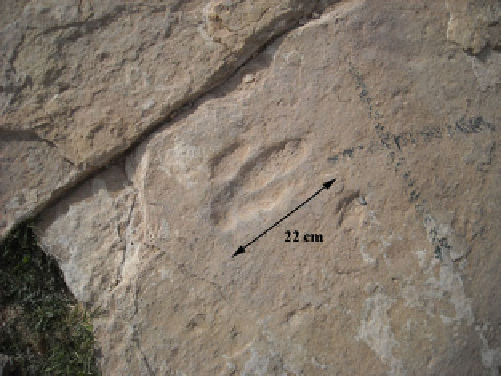Geology Reference
In-Depth Information
2011
). These tracks are much larger than previously
described, and are attributed to a large theropod.
In addition to the presence of dinosaur tracks, the Amoura
site has an excellent and very educational Cretaceous
stratigraphic cross-section, with layers ranging from Barre-
mian to Turonian without any gap (Figs.
4
and
5
). This
section was described in brief by Bellair and Lapparent
(
1948
) and in detail by Emberger (
1960
).
In addition to this geological treasure, Amoura is also an
old ksar (forti
ed villages) with beautiful gardens. It is also
worth mentioning the presence of an old sundial in the vil-
lage (Fig.
6
). Undoubtedly, with all these geological, his-
torical and cultural features, Amoura site is a good candidate
for geoheritage status.
Fig. 2
View of Amoura village
3.2
Tiout Footprints Site
The Amoura dinosaur footprints are located on the top of
a Cenomanian limestone slab containing mud cracks. Bellair
and Lapparent (
1948
) discovered 140 tridactyl footprints that
are divided according to size into three groups: (1) the
The Tiout Oasis is located in the Ksour Mountains (Saharan
Atlas), about 540 km southwest of Algiers and 12 km west
of Ain Sefra, in the Wilaya of Naama. Near the Tiout bridge,
at 1.75 km south-east of Tiout, Triassic-Jurassic (Rhetian-
Hettangian) rocks crop out along a major fault, which is
underlain by Triassic basalts and marls (Fig.
7
). The Trias-
sic-Jurassic rocks consist of rhythmically bedded dolomitic
limestones and dolomites. In this outcrop, Bassoulet (
1971
)
discovered about ten tridactyl footprints, which appear on a
vertically uplifted dolomitic limestone slab. The tracks are
located on 1 m
2
bedding surface. The length of the footprints
varies from 9 to 13 cm with a maximum width of 6 cm
(Fig.
8
). These theropod tracks were attributed to Grallator
variabilis (Bassoulet
1971
).
Tiout Oasis is also famous for its oldest known Prehis-
toric rupestrian carvings in North Africa, discovered in 1847.
These paintings depict elephants, buffaloes, ostriches that
lived in the area 7,000 years ago (Fig.
9
). A petri
rst
group includes the largest and most numerous footprints
(Fig.
3
); the length of a footprint of this group is 24 cm, the
width is 17 cm, and the stride length is about 80 cm on
average; (2) the second group is rarer; it includes small tri-
dactyl tracks (10 cm in length); and (3) the third group
includes even smaller tridactyl footprints (8 cm in length)
with digits more spread apart than digits of the other groups.
These tracks were attributed to a theropod dinosaur Col-
umbosauripus amouraensis (Taquet
2010
).
Recently, Mammeri et al. (
2011
) made a new discovery
of dinosaur footprints in the Cenomanian at Amoura, about
20 m stratigraphically below the surface on which the pre-
viously known dinosaur tracks are located. Thirty new large
tridactyl footprints were reported, with an average length of
61 cm and an average width of 49 cm (Mammeri et al.
ed forest
near Tiout has also been recently discovered. Unfortunately,
this unique geological and historical site is nowadays totally
dilapidated.
3.3
Belvedere-Akherdous (Djurdjura)
Footprints Site
In 1983, the third historical discovery of dinosaur footprints
in Algeria was made by Polish geologists in the Djurdjura
Mountains. In the middle unit of the
“
dorsale calcaire
”
of the
Djurdjura Mountains (Haizer
Akouker), the full Triassic
sequence, from the Anisian to Rhaetien, is well represented
in the Belveder-Akherdous locality. The Lower Triassic is
partly preserved and composed of few meters of clastic
deposits (yellow and red sandstones), the middle Triassic
strata are represented by up to 200 m of carbonate sediments
-
Fig. 3
Theropod footprint at Amoura track site



